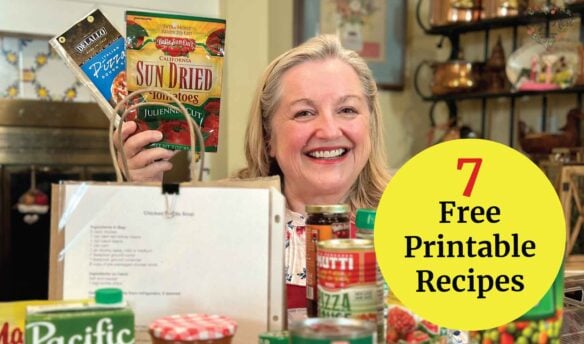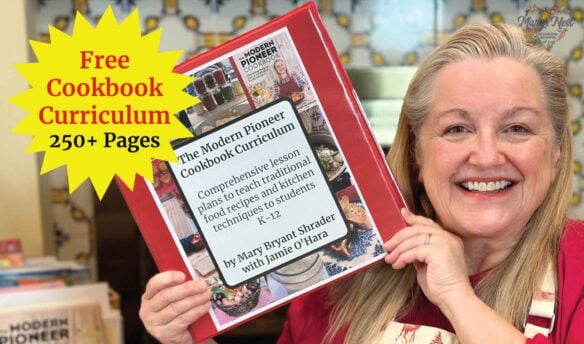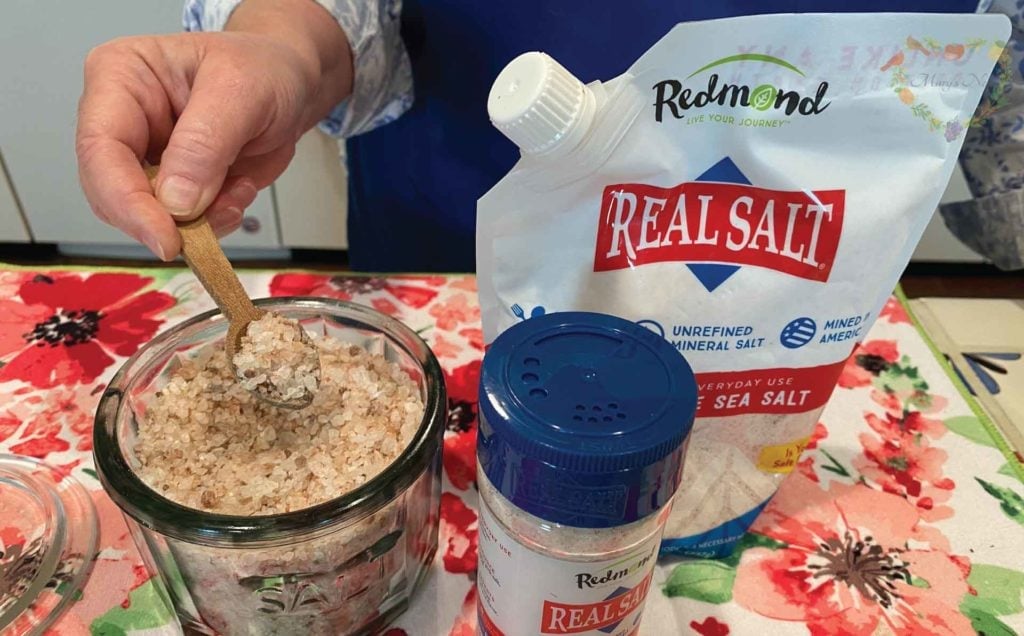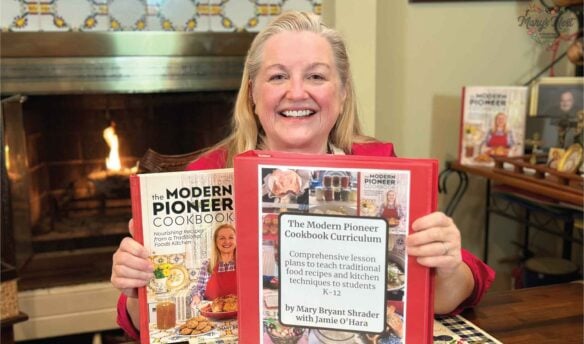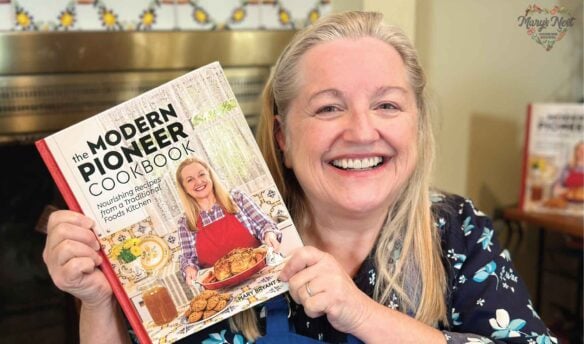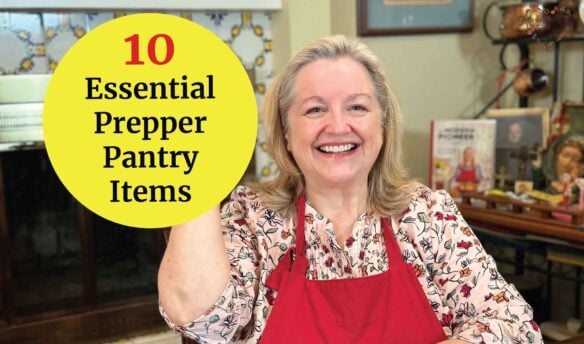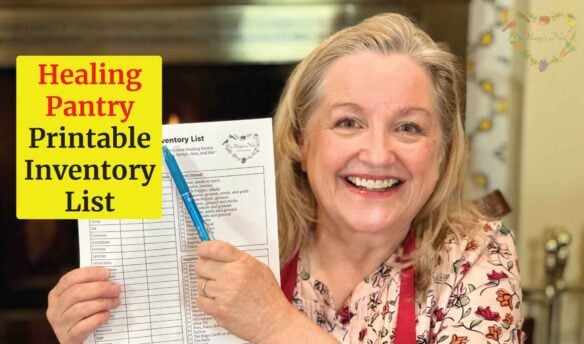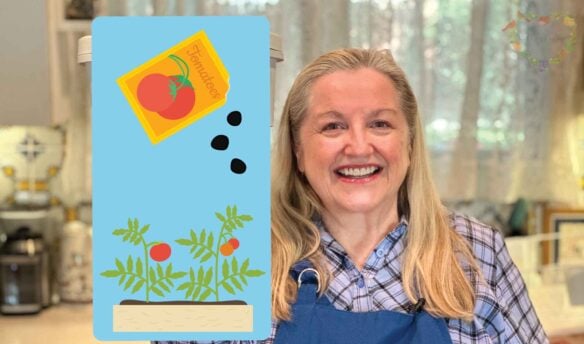As we live through these turbulent times, make sure you have your Prepper Pantry well stocked with the 27 BEST survival foods to help you weather any long-term emergency.
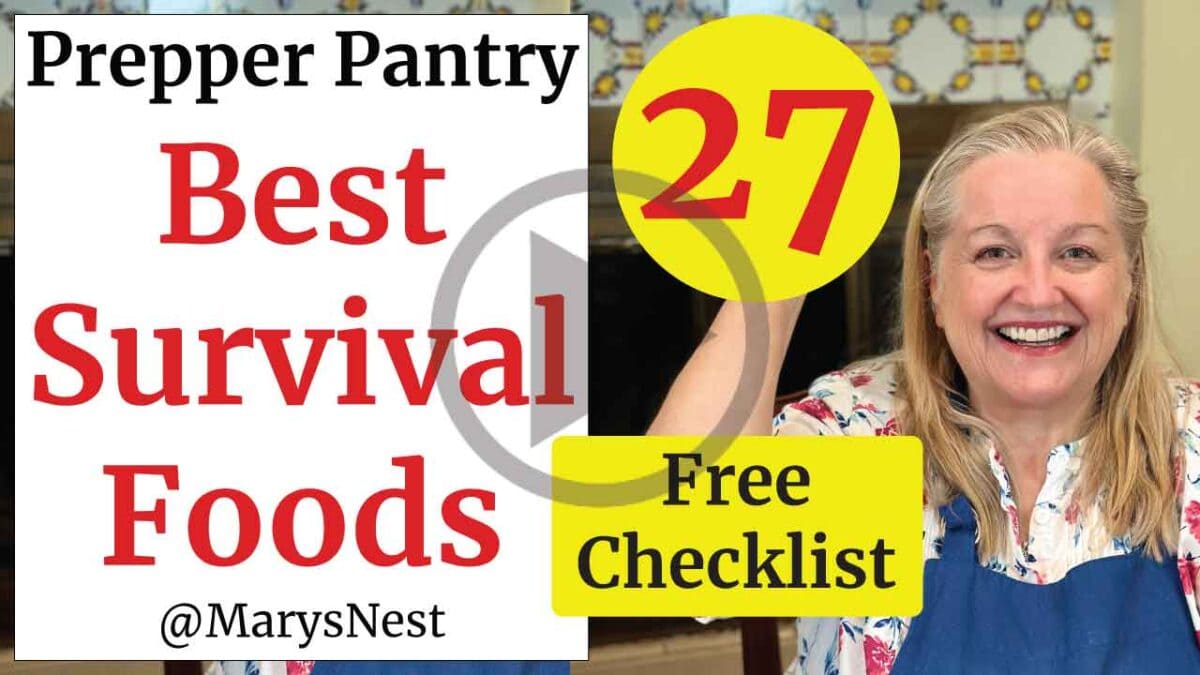
And be sure to download the free Survival Pantry Checklist to help you build your Survival Pantry with these foods.
Affiliates note: As an Amazon Associate I earn from qualifying purchases. My content may contain affiliate links to products and services. If you click through and make a purchase, I’ll receive a small commission. It does not affect the price you pay.
Table of Contents
- What is the Four Corners Pantry?
- What is a Prepper Pantry?
- The Backup Pantry
- The Emergency Pantry
- The Healing Pantry
- The Importance of the Survival Pantry
- What Are the Best Survival Foods Categories?
- Download the Survival Pantry Checklist
- More Free Downloads
- What Are the Best Survival Foods in the Baking Category?
- What Are the Best Survival Foods in the Beans Category?
- What Are the Best Survival Foods in the Beverages Category?
- What Are the Best Survival Foods in the Dairy Alternatives Category?
- What Are the Best Survival Foods in the Fats Category?
- What Are the Best Survival Foods in the Pasta Category?
- What Are the Best Survival Foods in the Proteins Category?
- What Are the Best Survival Foods in the Salts Category?
- What Are the Best Survival Foods in the Seasonings Category?
- What Are the Best Survival Foods in the Sweeteners Category?
- What Are the Best Survival Foods in the Fruits and Veggies Category?
- What Are the Best Survival Foods in the Whole Grains Category?
- What Are the Best Survival Foods in the Bonus Category?
- How to Properly Store Food
- Download Your Free 36-Page Pantry List
- The Modern Pioneer Cookbook
- Join the Traditional Foods Kitchen Academy
- Kitchen Academy Videos
- Shop for items used in this blog post or video
What is the Four Corners Pantry?
The Four Corners Pantry consists of your:
- Main Working Pantry
- Refrigerator
- Freezer
- Extended or Prepper Pantry
Your Main Working Pantry is specifically that area where you store non-perishable foods that you access on a daily basis. Your fridge and freezer are self-explanatory, but the term Extended or Prepper Pantry may be new to you.
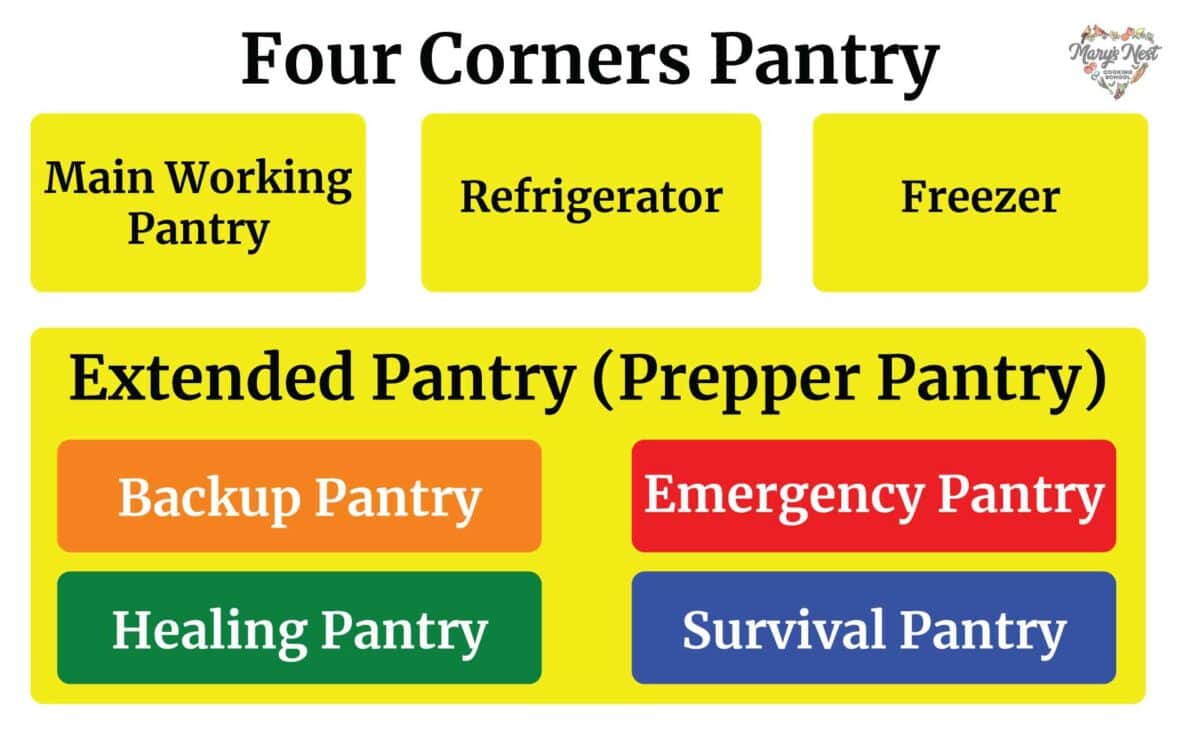
What is a Prepper Pantry?
Your Extended Pantry—what we often nickname our Prepper Pantry—is divided into four areas of sub-pantries. These include the:
Today, we’re focusing on stocking the Survival Pantry, but I want to share a brief overview of the other three subareas of the Prepper Pantry.
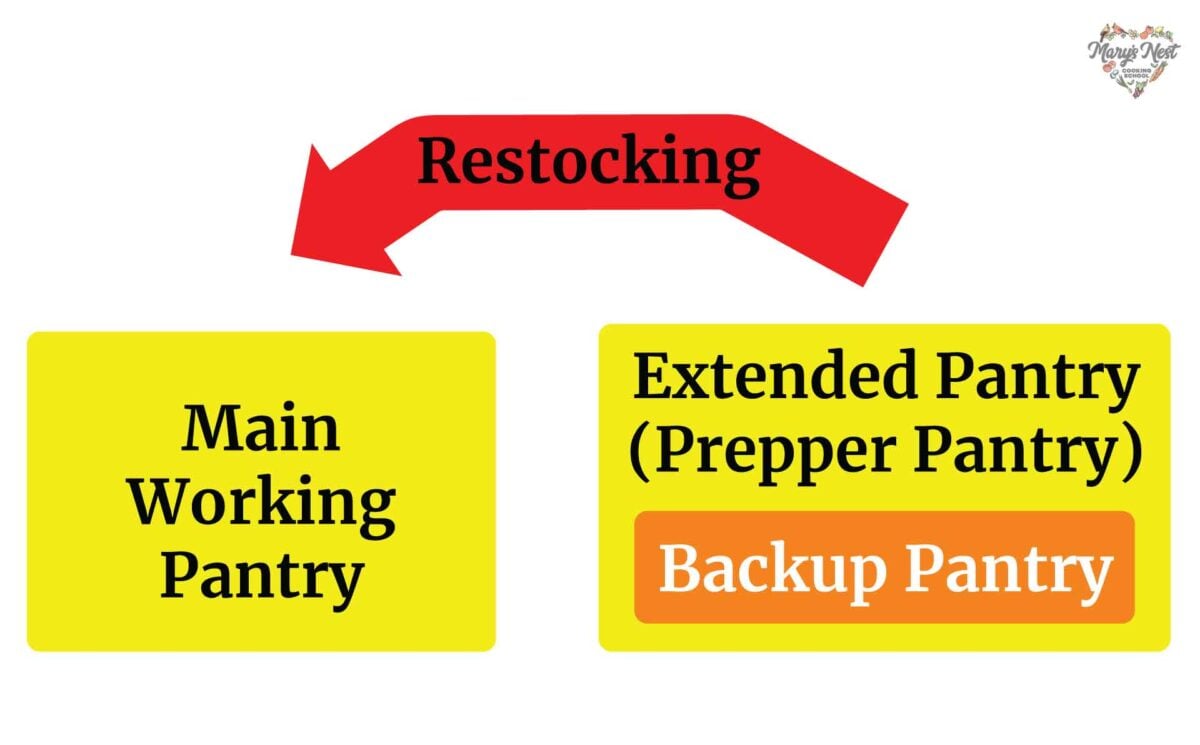
The Backup Pantry
The Backup Pantry is where you store extra non-perishable food that you access when you need to restock your Main Working Pantry. Having backup food on hand serves many purposes. It can help you from having to run out to the store every time you run out of something you need to prepare a meal, but it can also help you cope with other problems that might come your way, including:
- Bad weather
- Illness
- Inflationary prices
- Job loss (creating budget constraints)
- Shortages caused by supply chain problems
- Other unforeseen problems that are out of our control (Remember 2020!)
The Emergency Pantry
The Emergency Pantry is where you store two weeks of food that you can prepare without electricity or clean running water. You’ll want to keep this food in easy-to-access boxes so you can get to them quickly in an emergency.
In my How to Build a 2-Week Emergency Food Supply video, I provide you with helpful and detailed advice and a free “Two Week Emergency Food Supply Shopping List and Meal Plan” PDF you can download to create your Emergency Pantry with the food and supplies you need to prepare the food, such as a can opener.
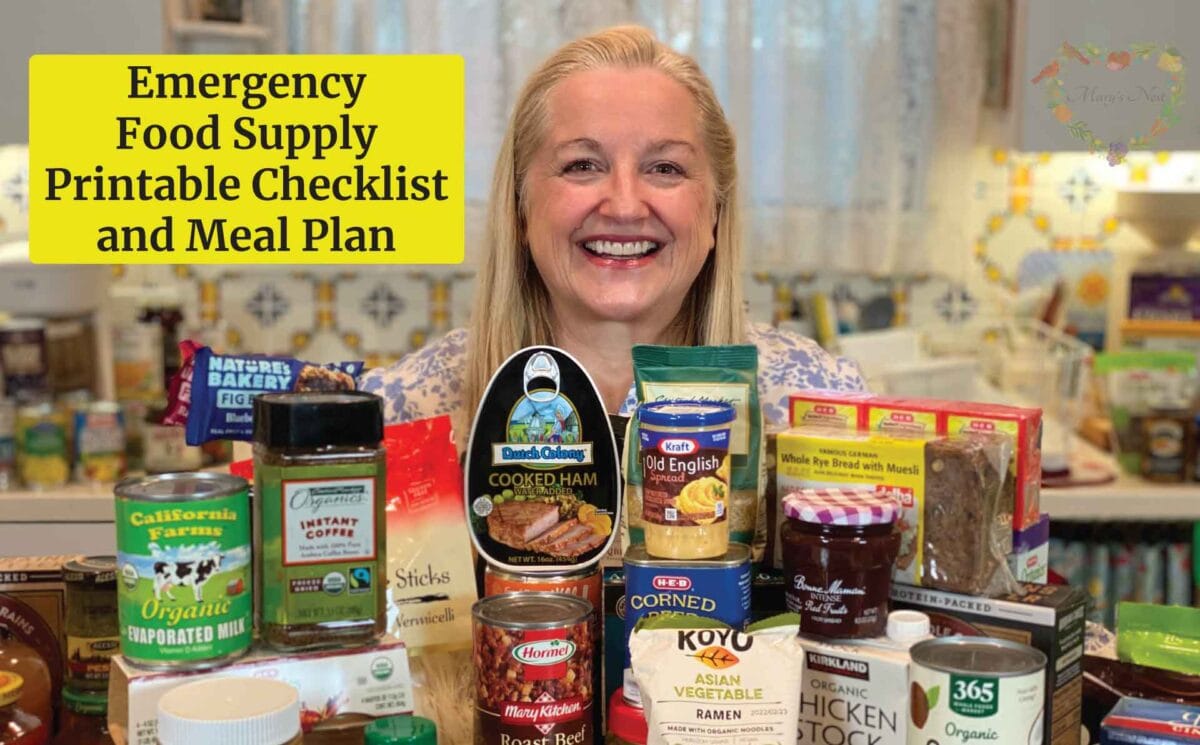
The Shopping List that’s part of the Emergency Pantry free download recommends the best foods to keep in your emergency supply boxes along with a one-week meal plan you can use to prepare the food you buy when you find that you have to “bug-in” (stay at home), but you are without electricity or water. Bad weather usually causes these types of emergencies.
After you’re done stocking your Emergency Pantry, you can store the one-week meal plan in the emergency supply boxes to make it easy for you to prepare meals when there may be a lot of factors creating stress for you, such as the lack of power or running water. (You can extend the meal plan to two weeks by repeating the previous week’s menu.)
Note: While you’re making your Emergency Pantry, also consider creating a bug-out bag in case you need to quickly leave your home. I show you how in my How to Pack Your Emergency Backpack Food Kit with Real Food video with a free download checklist.
Restock Your Emergency Pantry Every Year
You should restock your Emergency Pantry every year. As you restock your Emergency Pantry, you will roll over the existing food into your Backup Pantry or your Main Working Pantry. You want to do this because you are not concerned about stocking foods in your Emergency Pantry that have an extremely long shelf life or are forever foods—foods that will stay fresh indefinitely.
For example, your Emergency Pantry will contain foods that are easy to prepare, such as peanut butter. Nut butters often have a shelf life of up to one to two years, so you will want to rotate it out and restock your Emergency Pantry with fresher food.
The Healing Pantry
The Healing Pantry is where you store those various preparations for maladies that can arise at home but do not require a trip to the doctor or hospital. Your preparations can be either store-bought or homemade, and they can include bandages, aspirin, cough medicine, antibiotic ointment, etc.
I show you How to Stock Your Healing Pantry and Create an Herbal Medicine Cabinet with my detailed video and free Healing Pantry Printable Inventory List.
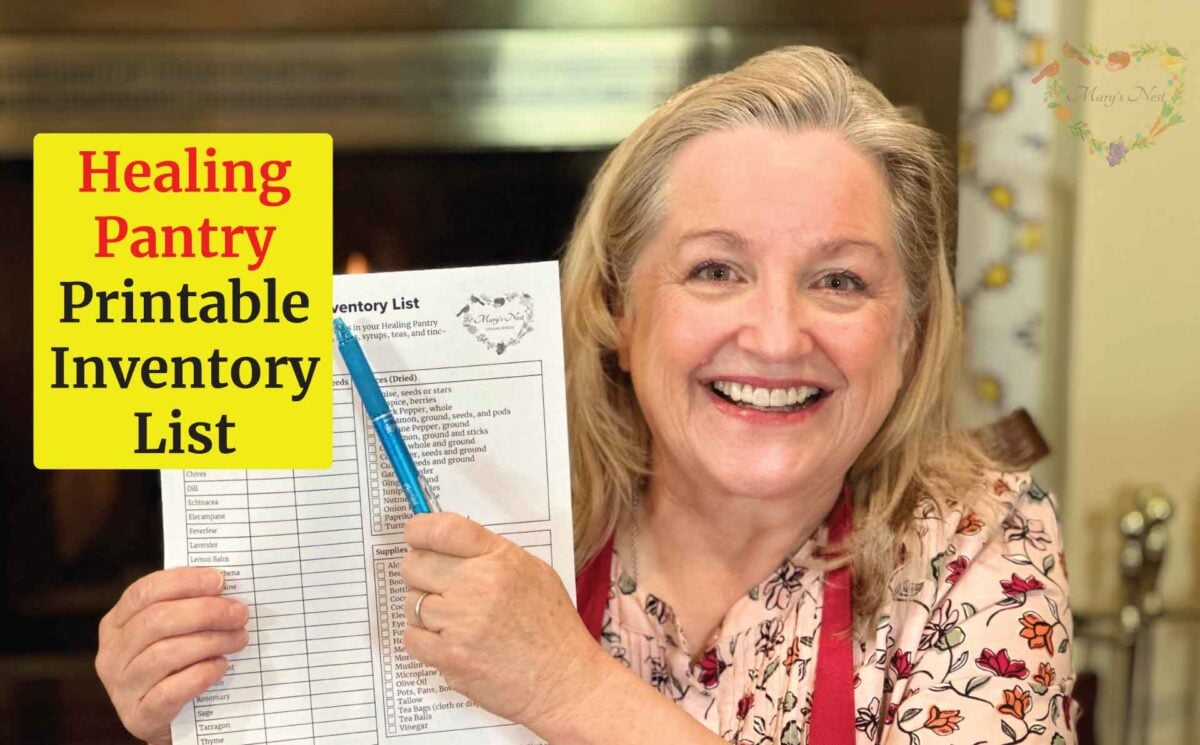
Herbal Medicine Cabinet
Within the Healing Pantry, I carve out a special area I call the Herbal Medicine Cabinet, where I keep the various herbs I use to make natural remedies along with the supplies needed to make these remedies. Also, in my Herbal Medicine Cabinet, I keep those various natural remedies I have already made and do not require refrigeration.
I show you how to make these natural remedies in detailed recipe videos, such as the following:
- How to Make a Great Night’s Sleep Herb Tea
- How to Make a Star Anise Tincture
- How to Make a Natural Antibiotic Ointment
Note that I don’t store all my natural remedies in my Herbal Medicine Cabinet. Here are some of the natural remedies I refrigerate and keep together in a plastic bin for easy access:
The Importance of the Survival Pantry
The Survival Pantry is where we store those foods with very long shelf lives and can be ready in the event of a long-term emergency, which might seriously limit our availability to obtain food and supplies.
Some of the non-food supplies you will use to cope with an extended emergency will be a crossover of the supplies you have already stocked in your Emergency Pantry. These non-food items range from simple can openers to more serious survival equipment like solar power stations.
However, the foods you stock in a Survival Pantry are quite different than those you would stock in your Emergency Pantry. What follows is a list of the 27 BEST foods you can stock in your Survival Pantry to make sure that you are well prepared to feed and nourish yourself, your family, and your friends if you need to cope with a long-term emergency.
What Are the Best Survival Foods Categories?
You’ll want to stock 12 categories of survival foods by ensuring you include at least one of each type of food from each category. These 12 categories of survival foods are:
- Baking
- Beans
- Beverages
- Dairy Alternatives
- Fats
- Pasta
- Proteins
- Salts
- Seasonings
- Sweeteners
- Fruits and Veggies
- Whole Grains
- Bonus
As I talk about in my Survival Pantry video, I describe 27 survival foods (and a few bonuses) spanning the 12 categories. You do not need to stock all 27 survival foods, but you want to include foods that offer varied nutrition, so try to pick at least one food from each category.
Foods with Indefinite Shelf Lives
As you go through these categories and individual foods, you might be surprised to learn that the United States Department of Agriculture (USDA) considers many of these foods to have indefinite shelf lives! When it comes to food sold in cans, bottles and jars, as well as those sold in paper or cardboard packaging, the USDA shares that these foods, if stored properly, have an indefinite shelf life and DO NOT go bad.
Do these foods lose some nutrition and, in the case of foods sold in paper or cardboard, begin to go stale over time? Yes, but they do not go bad. According to the USDA, these foods are safe to consume.
Learn more with these USDA references:
Just remember that you should store your survival foods in a cool, dark, dry area, and the cans, bottles, packaging, etc., should be in good condition and in no way dented or damaged. And, of course, always use common sense. If you open any of the canned, bottled, or packaged foods and you see spoilage, mold, smell an off-odor, or notice any type of bug infestation, discard them immediately and do not consume them.
Download the Survival Pantry Checklist
Be sure to download the following free Survival Pantry Checklist. You can take this checklist to the grocery store each time you shop. You do not need to buy all these foods in one trip but can spread your purchases over four weeks or longer as your budget allows. Before you know it, you will have a well-stocked Survival Pantry.
I also provide you with additional free downloads in the following section to help you with the overall task of stocking your entire Prepper Pantry, including all four sub-pantries (backup, emergency, healing, and survival).
If you’re unsure where to start, begin by downloading the inventory checklists that are part of my Why You Need to Stock Up On these Top 15 Foods NOW for Your Prepper Pantry video. The inventory checklists will help you know what you have before you even begin to stock up.
More Free Downloads
Download these free checklists and PDF files and add them to your kitchen journal.
How to Make Meal Prep Fast with the Meal-in-a-Bag System
Make meal prep fast and easy with these seven free recipes you can download and print out to create your own Meals in Bags.
The FREE Modern Pioneer Cookbook Curriculum – Teach Traditional Cooking Skills to Grades K-12
This cookbook curriculum gives students a love of traditional foods and kitchen skills that will last them a lifetime.
How To Build Your Great Depression Pantry
Download my free Great Depression Pantry Shopping Guide to identify the Depression Era Foods you need to stock to weather difficult times.
What Are the Best Survival Foods in the Baking Category?
You might be wondering how you are going to keep you baking supplies fresh for the long haul. Well, not to worry! In my Survival Pantry video, I share a clever way of keeping flour fresh without allowing it to develop any off odors.
- All-Purpose Flour
- Bread Flour
- Corn Starch (or Arrowroot Powder) (Note that for your working pantry, you can Learn How to Stock Your Baking Pantry with the Best Ingredients.)
- Baking Soda
- Baking Powder
- Vanilla Extract and other extracts (Note that you can learn How to Make Homemade Vanilla Extract.)
- Whole Spices
In addition to the clever tip I share with you in my Survival Pantry video, you can also learn how to keep your flour and other supplies fresh for the long term with these Prepper Pantry videos:
- The Best Food Storage Supplies for Your Prepper Pantry
- What is the Difference Between Oxygen Absorbers and Silica Gel Packs?
- How to Seal Mylar Bags in Seconds for Long Term Food Storage
- Answers to the Most Popular Long Term Food Storage Questions
And remember, you can also dehydrate your sourdough starter to save it for the long term.
What Are the Best Survival Foods in the Beans Category?
I know it is no surprise to find beans on a list of survival foods! These can be some of the best foods to store in your Survival Pantry because they can last a long time, are filling, and contain much needed protein in stressful long-term emergency situations.
- Canned Beans
- Dried Beans
Remember, when cooking beans under any circumstances, you want to cook them properly and thoroughly before consuming them. I share my favorite way to cook dried beans, but I also recommend that you read all about important safety tips when it comes to cooking beans with this caution on how to avoid poisoning from red beans.
In addition to my recipes, for more tips on how to best cook beans—including old beans—by brining them first, be sure to read Food Science Insights and Strategies from Dr. Guy Crosby. Plus, to learn what scientists discovered about 30-year-old beans, read all about storing beans from the Utah State University Extension Service.
What Are the Best Survival Foods in the Beverages Category?
When it comes to storing any beverage for the long haul, you want to stick with those beverages that are either freeze-dried and sealed well or are simply dried but have a quality to them that makes them excellent candidates for long-term storage. These beverage survival foods include:
- Freeze-dried Instant Coffee
- Black Tea
If you buy freeze-dried instant coffee at your local grocery store and do not open it but place it on a shelf in your Survival Pantry, it will last indefinitely. This type of coffee is considered a forever food and stores much better than roasted coffee beans or ground coffee. And you can store both caffeinated tea and decaf.
As to tea, your best option is to choose individually wrapped tea bags of black tea. If the individual packages are foil-lined, all the better! And as with coffee, whether the tea is caffeinated or decaf does not matter.
Can you store green tea and herb tea? Certainly, however, the shelf life will not be as long as that of black tea.
What Are the Best Survival Foods in the Dairy Alternatives Category?
Although we may keep dried milk—as in cow’s milk—in our Backup Pantry if we run out of liquid milk, dried milk doesn’t always make the best food for a Survival Pantry. The reason is that dried full-fat milk, as the name implies, contains fat. Since milk fat can go rancid fairly quickly, it is best kept as a short-term backup food.
On the other hand, non-fat or fat-free dried milk no longer has the fat, so it can be stored for a very long time. However, do we want to keep it? For a short-term, limited backup for when you run out of milk, it’s not the end of the world to use this dried milk. You will not be consuming this dried milk long-term, so it’s not much of a concern. However, I don’t recommend non-fat or fat-free dried milk for the Survival Pantry.
The reason is that non-fat dried milk is usually processed at very high temperatures, so the proteins may become denatured (damaged). During a long-term emergency, we want to ensure that we consume the healthiest foods we can find and limit those that provide empty or damaged calories.
In place of dried dairy milk, I recommend two dairy alternatives:
- Canned Coconut Milk
- Canned Coconut Cream
These are both shelf-stable and are high in fats that nourish our brains.
Evaporated Milk and Sweetened Condensed Milk
Now, what about evaporated milk and sweetened condensed milk? I show you how to make these both homemade when needed for a recipe.
You can also purchase these types of milks in cans at your local grocery store. However, they are both highly processed, so I do not recommend them for the Survival Pantry. Plus, sweetened condensed milk contains a significant amount of sugar, which can lower our immunity, and we don’t want to degrade our immunity during a long-term emergency.
What Are the Best Survival Foods in the Fats Category?
Ensuring you have high-quality, nutritious fats in your Survival Pantry is vital to good nutrition. Two that I recommend are:
- Coconut Oil
- Ghee or Clarified Butter
Coconut oil is high in lauric acid, which is difficult to find in other foods. This compound is highly beneficial in our diets because it is a strong antimicrobial that fights against a whole host of viruses and bacterial infections.
- Learn more with the research study: Measuring the Antimicrobial Activity of Lauric Acid against Various Bacteria in Human Gut Microbiota Using a New Method
Ghee or clarified butter are both shelf-stable fats that are not only nutritious but they are exceptionally delicious too. Both of these fats are made from butter, and the only difference is in flavor based on how they are prepared. Ghee has a more nutty flavor, while clarified butter is more mild.
In my new book, The Modern Pioneer Cookbook: Nourishing Recipes from a Traditional Foods Kitchen, I share how to make ghee and clarified butter. The process is easy, and both make outstanding additions to the traditional foods kitchen as they have a higher smoke point than butter, so they are perfect for pan frying.
What Are the Best Survival Foods in the Pasta Category?
If you have been with me for a while, you know that I am of Italian heritage, so if things get stressful around here in the future, I’m going to make sure I have plenty of pasta to keep my family well-fed and full through difficult times! So, it’s good to know that any pasta shape has a wonderfully long shelf life.
When you shop for pasta, make sure that you only buy pasta made with Durum Semolina so you know the pasta you buy is nutritious. You can also buy Durum Semolina egg pasta for added protein. The eggs in the pasta have been dried and are very shelf-stable.
- Durum Semolina Pasta
- Durum Semolina Egg Pasta
What Are the Best Survival Foods in the Proteins Category?
Thanks to the USDA research I shared above, we can put cans of these high-protein foods on the shelves of our Survival Pantry, and we can be assured that when stored properly, these canned proteins can last a very long time!
- Canned Fish and Canned Meats
- Aseptic and Canned Soups and Stews
Canned small fish, like kippers and sardines, is one of my first choices when stocking protein in a Survival Pantry since these foods are high in Omega-3 Fatty Acids and are a nutrient-dense food.
As my mom used to say, fatty small fishes are brain food, and mothers are always right! 😉Scientists also concur that fish high in Omega-3s nourish our brains and hearts.
Make these delicious recipes with your canned fish and meats:
- The Best Sardines Recipe for Canned Sardines
- How to Make an Easy Meal with Kipper Snacks
- How to Make Salmon Patties with Canned Salmon
- How to Make Tuna Boat Surprise Using Canned Tuna
- How to Make Chicken Patties Using Canned Chicken
What Are the Best Survival Foods in the Salts Category?
When it comes to salt, make sure that you (1) stock sea salt for the minerals that it offers and (2) iodized salt. In a long-term emergency situation, we have no idea what foods we may or may not be able to obtain.
- Sea Salt
- Iodized Salt
If we were to run low on foods, such as fish that are rich in iodine, we might risk developing goiter, a condition that affects the thyroid. Making sure you have iodized salt on hand can help defend against that.
Also, although not directly on this list, consider adding potassium chloride and magnesium to your list of supplies so you can make a homemade electrolyte drink. But if you did not have these on hand, you can also learn how to make a simply old-fashioned electrolyte drink with raw apple cider vinegar, molasses, and water with my How to Make Switchel recipe video
Not all salts are created equal. You can learn more about The Best Salts with the Least Amount of Microplastics.
Redmond Real Salt
When it comes to using salt in my recipes, I always like to use a real salt that has not been processed and does not contain any extra added chemicals or anti-caking agents. Redmond real salt is perfect! And if you’d like to order Redmond Real Salt from their website, be sure to check out my Shopping Guide for a discount coupon code.
- Redmond Real Life – For Real Salt and other products, use this link and discount code MARYSNEST for 15% off your purchase. (Discount will show at checkout.)
What Are the Best Survival Foods in the Seasonings Category?
When storing seasonings, your best bet for satisfactory long-term storage will be to keep your seasonings in their whole form. Can you store ground seasonings? Certainly, their flavor may fade over time, more so than with whole spices, so you may need to use more. (Keep that in mind.)
- Seasonings – preferably whole as in peppercorns, chilies, etc.
What Are the Best Survival Foods in the Sweeteners Category?
Having something sweet during stressful times can be incredibly comforting. However, you also want to make sure that whichever sweetener you store, you limit your consumption of white sugar.
You want to rely on sweeteners that have their nutrition intact. Both liquid and dry sweeteners have extended shelf lives to the point where many are considered forever foods!
- Honey and other liquid sweeteners, including coconut syrup, date syrup, maple syrup*, and molasses
- Dry Sweeteners, including dried whole sugar cane, coconut sugar, date sugar, and maple sugar
*Keep in mind that once you open maple syrup, you need to refrigerate it due to its higher water content, which could lead to spoilage.
Not all sugars are equal. You can learn more with Which Sugar is the Best? Essential Sugars for Your Prepper Pantry video and blog post.
What Are the Best Survival Foods in the Fruits and Veggies Category?
The fruit and vegetable choices you have available are quite endless. You just need to determine what you like and what you think you will eat. You can dry your own fruits and vegetables if you want, but these foods are also abundant at most grocery stores.
- Canned or Bottled Fruits and Veggies
- Dried Fruits and Dehydrated Veggies
As I have mentioned in this post, the USDA shares that most canned, bottled, and packaged foods, when stored correctly, have an indefinite shelf life.
What Are the Best Survival Foods in the Whole Grains Category?
Even though whole grains have their bran and germ intact, they have exceptionally long shelf lives. Many whole grains can last for 25 years and beyond when stored correctly!
- Whole Grains and Rice
And when I mention whole grains, I refer to any type of grain, from modern-day whole-grain wheat berries to ancient grains, including einkorn, emmer, or spelt berries. Learn more with my Frequently Asked Questions About Wheat Berries post.
Although white rice is not a whole grain, it is a superb vehicle for including other nutrient-rich and nutrient-dense foods in our diets. You can prepare white rice with bone broth, ghee, and sea salt, and you have created a nutritious dish. But in terms of long-term storage, white rice is an ideal addition to the Survival Pantry because since the bran and germ have been removed, it has a very long shelf life, unlike brown rice, which still has the bran and germ.
What Are the Best Survival Foods in the Bonus Category?
You know I always like to throw in a bonus for you, and here it is! Every Survival Pantry should include raw vinegar and real soy sauce. These foods add probiotics to our diets, improving our overall digestive health. Keeping our guts healthy helps keep our entire body healthy.
- Raw Vinegars
- Fermented Soy Sauce
How to Properly Store Food
Throughout this post, I have stressed the importance of properly storing food. To learn how to use different storage containers, including food-safe buckets and mylar bags, be sure to watch my series of videos where I discuss the different storage containers.
You’ll also learn the difference between oxygen absorbers and silica gel packs, along with how to use Foodsaver products to vacuum seal your food.
Download Your Free 36-Page Pantry List
For an extensive list of the traditional foods you can make and purchase to stock your pantry, be sure to download my free 36-page Traditional Foods Pantry List. This comprehensive eBook is full of links to recipe videos, helpful articles, and more!
And if you’re looking for a printed book full of my traditional foods recipes that shows you how to create a traditional foods kitchen, be sure to order your copy of my new book, The Modern Pioneer Cookbook. (HONEY – Can you make the Order Now button below RED)
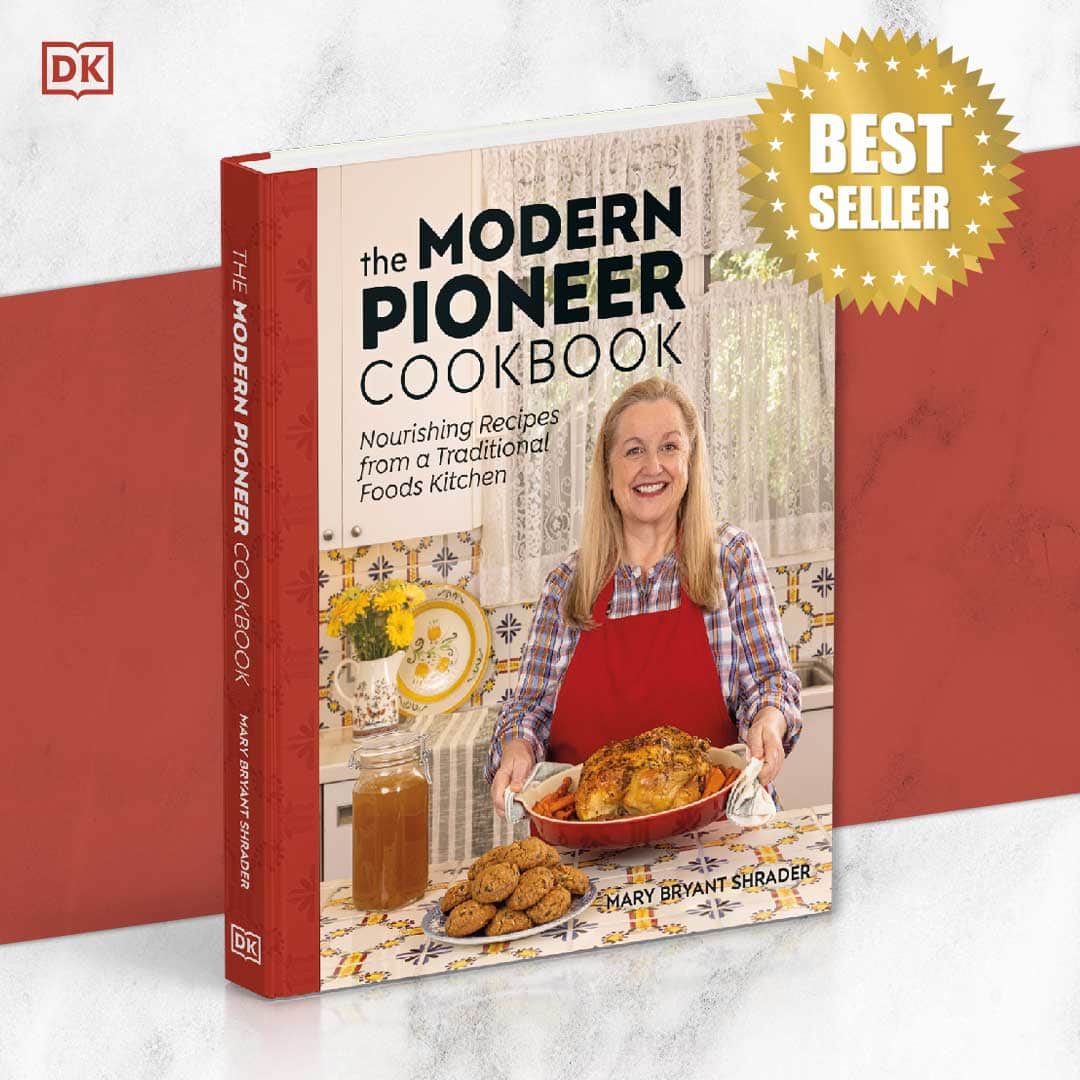
Order YOUR COPY Now!
The Modern Pioneer Cookbook
Seasonal ingredients, traditional techniques, and nourishing recipes. Over 85 traditional, from-scratch recipes! Discover for yourself how you can use simple ingredients and traditional techniques to cook the modern pioneer way.
Join the Traditional Foods Kitchen Academy
Are you looking for more traditional foods videos? If so, I invite you to join the Traditional Foods Kitchen Academy. Members of this optional paid YouTube community get access to exclusive videos, live streams, and other members-only perks. Plus, your YouTube comments include a special members-only badge.
Kitchen Academy Videos
Does Eating Food in a Specific Order Fight Disease?
Research suggests that the order in which we eat our food may significantly impact our health and ability to fight disease.
Why I Created The Modern Pioneer Cookbook Curriculum
I chat about why it was important for me to create this comprehensive curriculum for students in grades K-12.
Taking a Sneak Peek at Upcoming Recipes on Mary’s Nest
I share upcoming recipes and what I have planned for my Mary’s Nest YouTube channel in 2024.
Stay in Touch with Mary’s Nest
- Subscribe to My YouTube Channel for Traditional Foods Videos (Free) - When you subscribe, be sure to click on the notification bell that will let you know each time I upload a new video.
- Subscribe to Mary’s Traditional Foods Newsletter (Free) - Get a free 36-page eBook for signing up: How to Stock Your Essential Traditional Foods Four-Corners Pantry.
- Join the Traditional Foods Kitchen Academy (Optional Paid) - For more detailed videos and exclusive members-only perks, join my YouTube membership community.
- Order The Modern Pioneer Cookbook (Optional Paid) - Get a printed book of Mary's nourishing recipes from a Traditional Foods Kitchen. This bestselling cookbook is published by Penguin Random House with their DK imprint.
I look forward to having you join me in my Texas Hill Country Kitchen!
Shop for items used in this blog post or video
Favorite Prepper Pantry Supplies
- Favorite Aprons
- FoodSaver Handheld Vacuum Sealing System
- FoodSaver Bags
- 5 Gallon Buckets with Lid
- Bucket Lid Opener Tool
- Bay Leaves
- 1 Gallon Mylar Bags
- 300CC Oxygen Absorbers
- 10g Silica Gel Packs
Amazon Shop and Shopping Guide
- Visit Mary’s Nest Amazon Shop
- Visit my Shopping Guide page
Get up to 15% off for stocking your Traditional Foods Pantry and equipping your Modern Pioneer Kitchen, including discounts from US Wellness Meats, Farmhouse Teas, Lehman's, Masontops, Cultures for Health, Survival Garden Seeds, Redmond Real Salt, Plan to Eat, and More!
